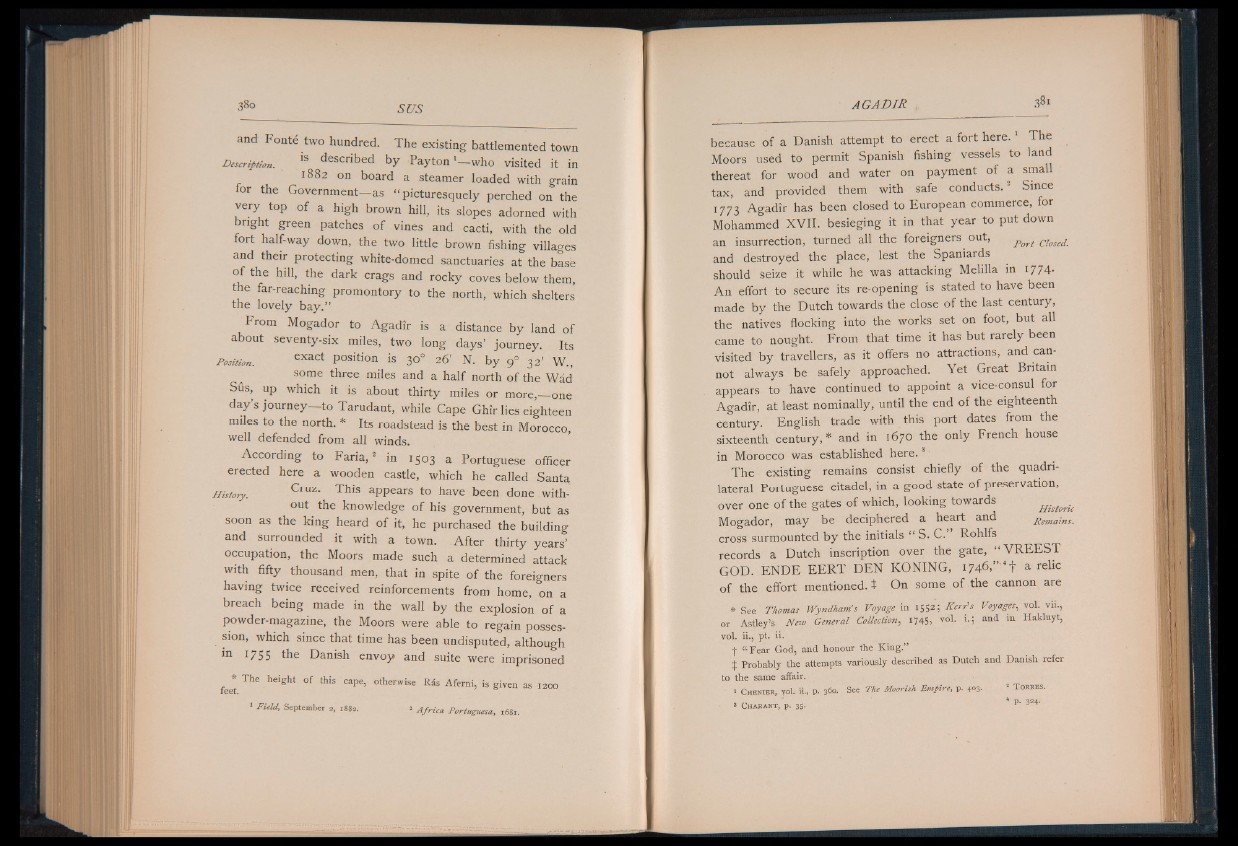
and Fonte two hundred. The existing battlemented town
Description. *S described by Payton1— who visited it in
1882 on board a steamer loaded with grain
for the Government-as “ picturesquely perched on the
very top of a high brown hill, its slopes adorned with
bright green patches of vines and cacti, with the old
fort half-way down, the two little brown fishing villages
and their protecting white-domed sanctuaries at the base
o f the hill, the dark crags and rocky coves below them,
the far-reaching promontory to the north, which shelters
the lovely bay.”
From Mogador to Agadir is a distance by land of
about seventy-six miles, two long days’ journey. Its
Position. exact Position is 30° 26' N. by 90 32' W.,
some three miles and a half north of the Wad
Sus, up which it is about thirty miles or more,— one
day’s journey— to Tarudant, while Cape Ghir lies eighteen
miles to the north. * Its roadstead is the best in Morocco,
well defended from all winds.
According to F a ria ,s in 1503 a Portuguese officer
erected here a wooden castle, which he called Santa
History. Cruz. This appears to have been done without
the knowledge of his government, but as
soon as the king heard of it, he purchased the building
and surrounded it with a town. After thirty years’
occupation, the Moors made such a determined attack
with fifty thousand men, that in spite of the foreigners
having twice received reinforcements from home, on a
breach being made in the wall by the explosion of a
powder-magazine, the Moors were able to regain posses-
sion, which since that time has been undisputed, although
l 755 the Danish envoy and suite were imprisoned
feet The hClght ° f ^ C3Pe’ 0therwise Aferni> is given as 1200
1 Field, September 2, 1882. 2 A fr ica Portuguese, r68i.
because of a Danish attempt to erect a fort h e re .1 The
Moors used to permit Spanish fishing vessels to land
thereat for wood and water on payment of a small
tax, and provided them with safe conducts.2 Since
1773 Agadir has been closed to European commerce, for
Mohammed XVII. besieging it in that year to put down
an insurrection, turned all the foreigners out, closed.
and destroyed the place, lest the Spaniards
should seize it while he was attacking Melilla in 1774*
An effort to secure its re-opening is stated to have been
made by the Dutch towards the close of the last century,
the natives flocking into the works set on foot, but all
came to nought. From that time it has but rarely been
visited by travellers, as it offers no attractions, and cannot
always be safely approached. Y e t Great Britain
appears to have continued to appoint a vice-consul for
Agadir, at least nominally, until the end of the eighteenth
century. English trade with this port dates from the
sixteenth century,* and in 1670 the only French house
in Morocco was established here. *
The existing remains consist chiefly of the quadrilateral
Portuguese citadel, in a good state of preservation,
over one of the gates of which, looking towards j g l i
Mogador, may be deciphered a heart and Remains.
cross surmounted by the initials “ S. C. Rohlfs
records a Dutch inscription over the gate, “ V R E E S T
GOD. ENDE EERT DEN KONING, I 746,” 4t a relic
of the effort mentioned, t On some of the cannon are
* See Thomas Wyndham's Voyage in 1552; Kerr’s Voyages, vol. vii.,
or Astley’s New General Collection, 1745, vol. i.; and in Hakluyt,
vol. ii.5 pt. ii.
+ “ Fear God, and honour the King.”
f Probably the attempts variously described as Dutch and Danish refer
to the same affair.
• C h e n i e r , vol. ii., p. 360. See The Moorish Empire, p . 403. 2 T o r r e s .
* T). 324.